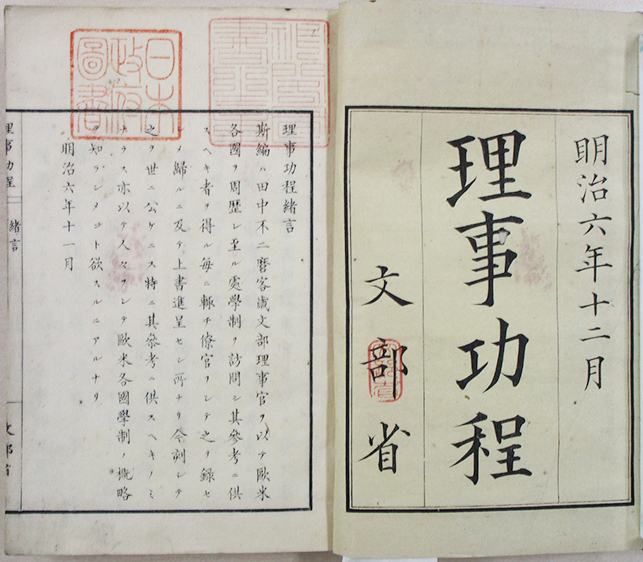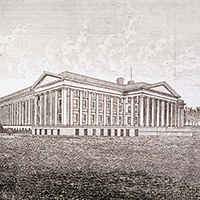
Explanatory Column
Treaty revision negotiations by the Iwakura Mission and their legacy
December 23, 1871, the Iwakura Mission left Yokohama for the United States, the first stop on its expedition. The duties of the Iwakura Mission were roughly centered around the following three goals: (1) to call on the heads of state for each country visited, present an official diplomatic document from the emperor, and make courtesy calls in countries for which treaties were not yet concluded; (2) approach or begin preliminary negotiations for treaty revisions to include extensions of approaching discussion; (3) investigate and study various systems, industries, and cultures in America and Europe.(Ref.A04017147400).
The most vital of these goals was considered to be the second, since preliminary negotiations and treaty revisions were considered the best way to place Japan on equal footing with America and Europe while showing Japan to the global community.
On February 29, 1872, the Iwakura Mission arrived in Washington D.C. They visited the White House on March 4 (Ref. A04017148600) and held audience with U.S. President Grant, to whom they presented official diplomatic documents. At a ceremony, extraordinary and plenipotentiary ambassador Iwakura Tomomi in a speech declared that Japan would learn about foreign societies and build friendly diplomatic ties with America and Europe (Ref.A04017149200).
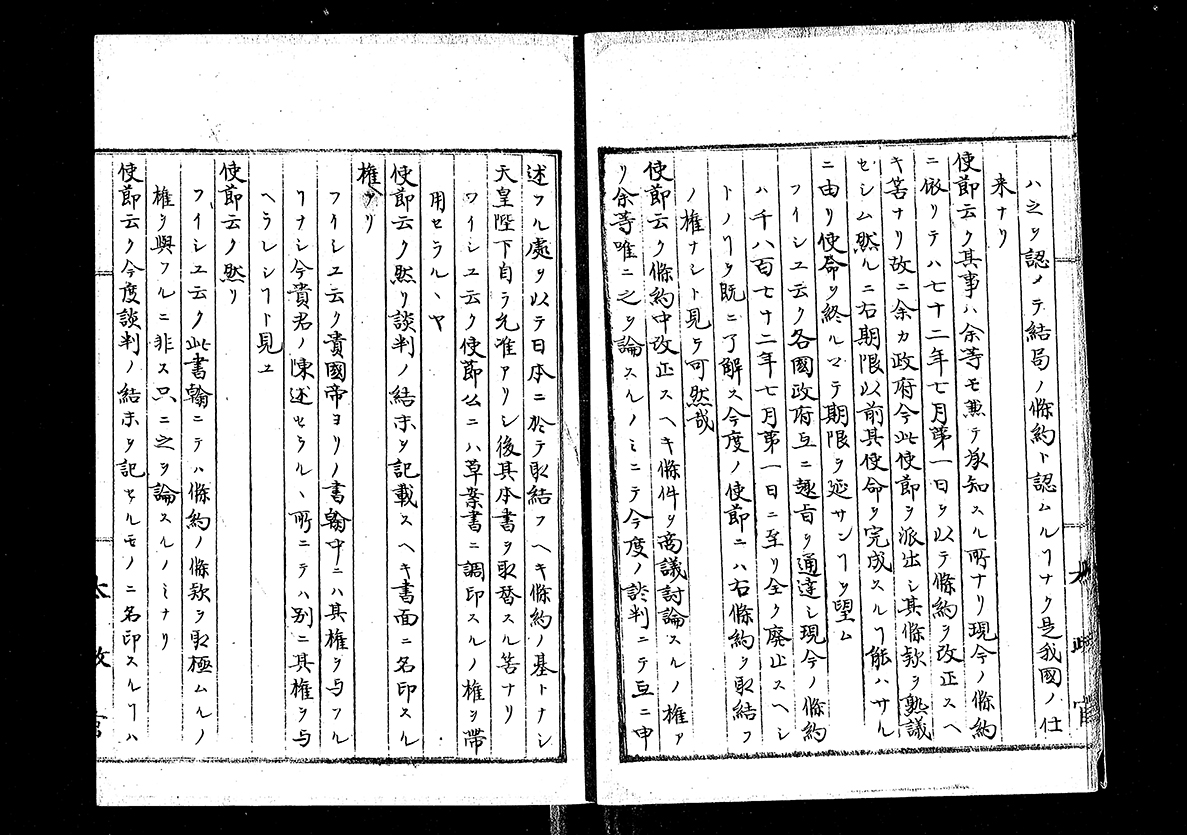
On March 11, the first official meeting in the United States was held at the office of the US Secretary of State (Ref.A04017148800). At the start this meeting, the Japanese requested an extension of the treaty revision period and then began negotiations for talks on future revisions. In addition, they emphasized that they had the authority to sign a treaty.
Secretary of State Fish, however, insisted that while the Japanese could discuss the treaty, they did not have plenary power and so were not authorized to sign.
This statement had not been anticipated by the Japanese. The main subjects of the talks for the day became the extension of the period for treaty revisions and whether the Japanese had authority to sign a new treaty, and so questions and answers went back and forth between the two sides and, day’s talks ended without a concrete agreement from the Americans.
After the first talk, Ito Hirobumi and Mori Arinori proposed to switch the official revision talks from the preliminary negotiations of the treaty. The enthusiasm with which Mori and Ito appealed for the need for plenary power largely changed the purpose of the mission and became a key factor leading to the extension of their stay in America.
March 13, Iwakura called the envoy extraordinaries and minister plenipotentiaries Kido, Okubo and Ito for discussions on whether the mission should enter into negotiations for treaty revisions. This resulted in a decision to begin official negotiations. On March 20, Ito and Okubo returned to Japan temporarily and made preparations for the assumption of full authority.
Just before their return to Japan, Ito and Okubo discussed with Iwakura and Kido the main points to consider regarding the progress of past talks. It was determined that as for the consular jurisdiction and the tariff autonomy went, treaty revisions would succeed if some conditions were satisfied in future negotiations.
However in actual fact, the gap between Japan and the United States was growing wider along with repeated talks, and signs of breakdown in negotiations were expected unless conflicting opinions could be resolved (Ref.A04017148800).
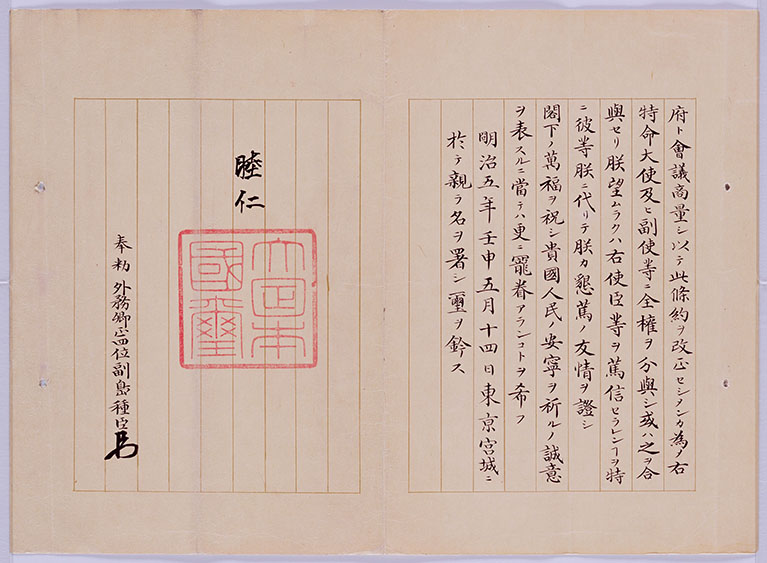
Finally, on July 22, after approximately four months had passed, Ito and Okubo, with their newly acquired full authority arrived at Washington. Just before they arrived in the US for a second time, Iwakura and Kido had planned to hold a joint meeting with Europe for treaty signing. If the Americans refused, they would decide to cancel negotiations for treaty revisions. As a result of discussions with Ito and Okubo after their arrival regarding policies already decided out of necessity, they were forced to accept the reality that the treaty draft from the Japanese side could not be accomplished.
Iwakura and others participated in an eleventh meeting of the same day, the proposal of the Japanese was again refused by America, and the negotiations for treaty revision broke down without reaching an agreement.
In the end, Japan and the United States could not find a compromise, and a treaty was never signed. In this way, eleven negotiation rounds with the United States ended in failure. Afterwards, there also weren’t any substantial advances in negotiations with other countries.
Still, it is thought that the significance of the Iwakura Mission was great – because the information and experience that the mission gained abroad had a great influence on future Japanese foreign ministers and their methods of negotiation.
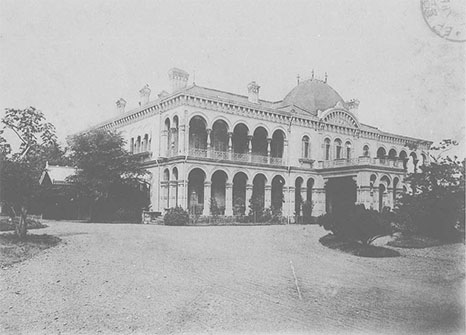
"Album of Tokyo by phototype" (National Diet Library digital collection, Call Number:404-3)
Foreign Minister Inoue Kaoru who succeeded former Foreign Minister Terashima Munenori was greatly influenced through contact with the West. In 1883, as a gesture of welcome to foreign visitors, he built a Western-style building called Rokumei-kan and promoted a Westernization policy that paralleled revision negotiations. At Rokumei-kan, opportunities for interchange with foreigners on official and private matters increased, and substantial diplomatic activities came about through deepening friendships.
At this time, the "westernization policy," kept an aim to push negotiations for treaty revision forward smoothly by promoting the idea both domestically and internationally that Japan was already a modern nation. Like Ito, Inoue was active in the process of westernization, but Inoue had not been part of the mission. However, it may be said that the reason he could create such a concept was due to the influence of the mission and Foreign Minister Terashima, whom he succeeded.
It is reasonable that the dispatch of the Iwakura Mission formed the basis for Japan’s development into a modern nation, and contributed to late Meiji era revisions on unequal treaties, the abolishment of consular jurisdiction, and the recovery of tariff autonomy.
大久保利謙『岩倉使節団の研究』(宗高書房、1976年)
石井孝『明治初期の国際関係』(吉川弘文館、1977年)
宮永孝「米国における岩倉使節団 岩倉大使の条約改正交渉」(『社會勞働研究(法政大学)』第38巻第2号、1992年)
田中彰『岩倉使節団の歴史的研究』(岩波書店、2002年)
李啓彰「井上馨による「裏舞台」の創出―鹿鳴館の建設過程からの考察―」(『社会システム研究(立命館大学)』第22号、2011年)
奥田和彦「岩倉使節団の文化的帰結」(『国際交流研究 国際交流学部紀要(フェリス女学院大学)』(19)、2017年)
Department of Justice - Inspection of Western nations and the compilation of a legal code
The early Meiji Japanese Government confronted unequal treaties with other countries, making it challenging to establish a modern legal system. As a result, a number of people in the Iwakura Mission had been dispatched by the Department of Justice to study legal systems namely, Councilor Sasaki Takayuki, and his attendants Okauchi Shigetoshi, Nakano Takeaki, Hiraga Yoshitada and Nagano Fumiakira along with Iwakura. Members of the mission were joined abroad by eight others: Kono Togama, Tsuruta Akira, Kishira Kaneyasu, Inoue Kowashi, Masuda Katsunori, Numa Morikazu, Namura Taizo, and Kawaji Toshiyoshi. How much did the Department of Justice contribute to the mission and the establishment of the Japanese judicial system?
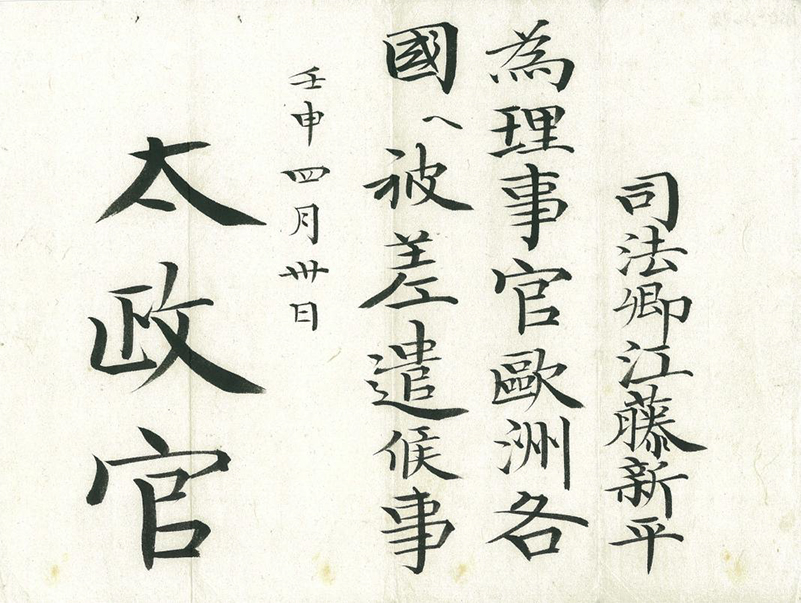
Late arrivals to the mission from the Department of Justice were originally intended to accompany Minister of Justice Eto Shinpei to Europe. Eto had been working on establishing the department and systemic civil codes as an investigative managing director before he was appointed as minister of justice, April 1872. Soon after he assumed office, Eto received a written appointment to head to Europe to research and study legal systems – the French system in particular. However, Eto had his hands tied working on the creation of judiciary offices, such as the Meiho-ryo (later, School of Legal Studies of Ministry of Justice) and the prefectural courts. Eto gave up his chance to visit Europe out of necessity after persuading from Sanjo Sanetomi. Without him the Department of Justice inspection party that departed for France was composed of eight individuals, including Kono.
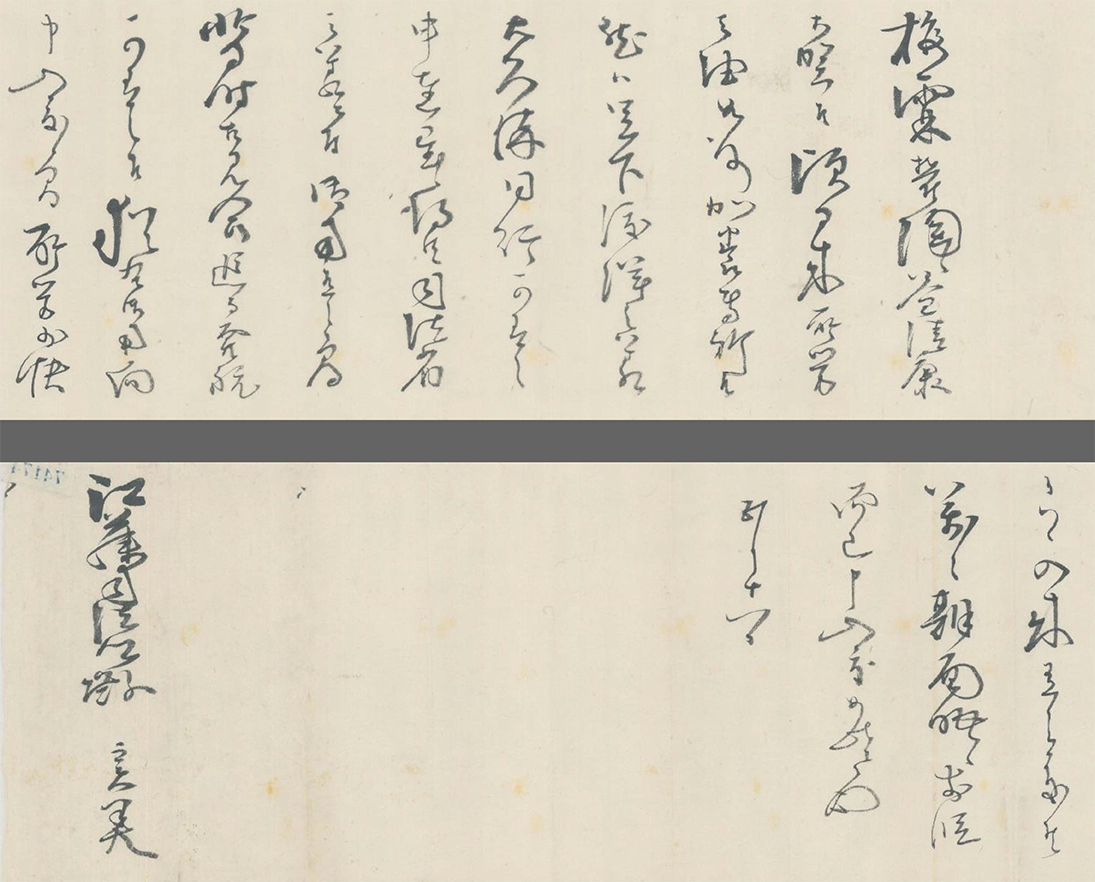
The purpose of the Department of Justice inspection was not just to study European legal systems. One of their most important goals involved extending invitations to European jurists to become foreign consultants. Eto established the "Civil Law Assembly" in 1870, before being appointed Minister of Justice, and commissioned Mitsukuri Akiyoshi to translate the French civil code. He had intended to draft the Japanese civil code based on the translations, however, translation proved difficult for Mitsukuri, as neither a French-Japanese dictionaries nor teachers who taught French existed in those days and Eto valued promptness over accuracy. Mitsukuri appealed to Eto for permission to travel abroad to learn French law, but Eto, who was in a hurry to get his translations performed, suggested that receiving a lawyer from Europe instead would enable Mitsukuri to ask whatever he needed much faster than if he were to travel to Europe. Eto also suggested gathering students who could also learn from the foreign lawyer.
This proposal was accepted, and the Department of Justice inspection party and Sameshima Naonobu, who was Minister to France at the time, began to petition for the selection of a suitable foreign consultant.
French jurist Boissonade was selected and came to Japan to fill the role of foreign consultant. Boissonade was born in 1825. After receiving a doctorate in judicial studies from the University of Paris in 1852, he became an assistant professor of the university in 1867, by way of the University of Grenoble. Boissonade, who received a request from Minister Sameshima, lectured to Department of Justice inspection party members Tsuruta, Kishira, Inoue, Namura, Kawaji, and Imamura Waro who had been dispatched to Europe by the Ministry of Education. Boissonade received his invitation to work in Japan from Sameshima per Eto’s instruction. The negotiations of the invitation encountered difficulties, but in June 1873, Boissonade at last signed a contract with the Japanese government abroad and, in November of the same year, traveled to Japan accompanied by Namura.
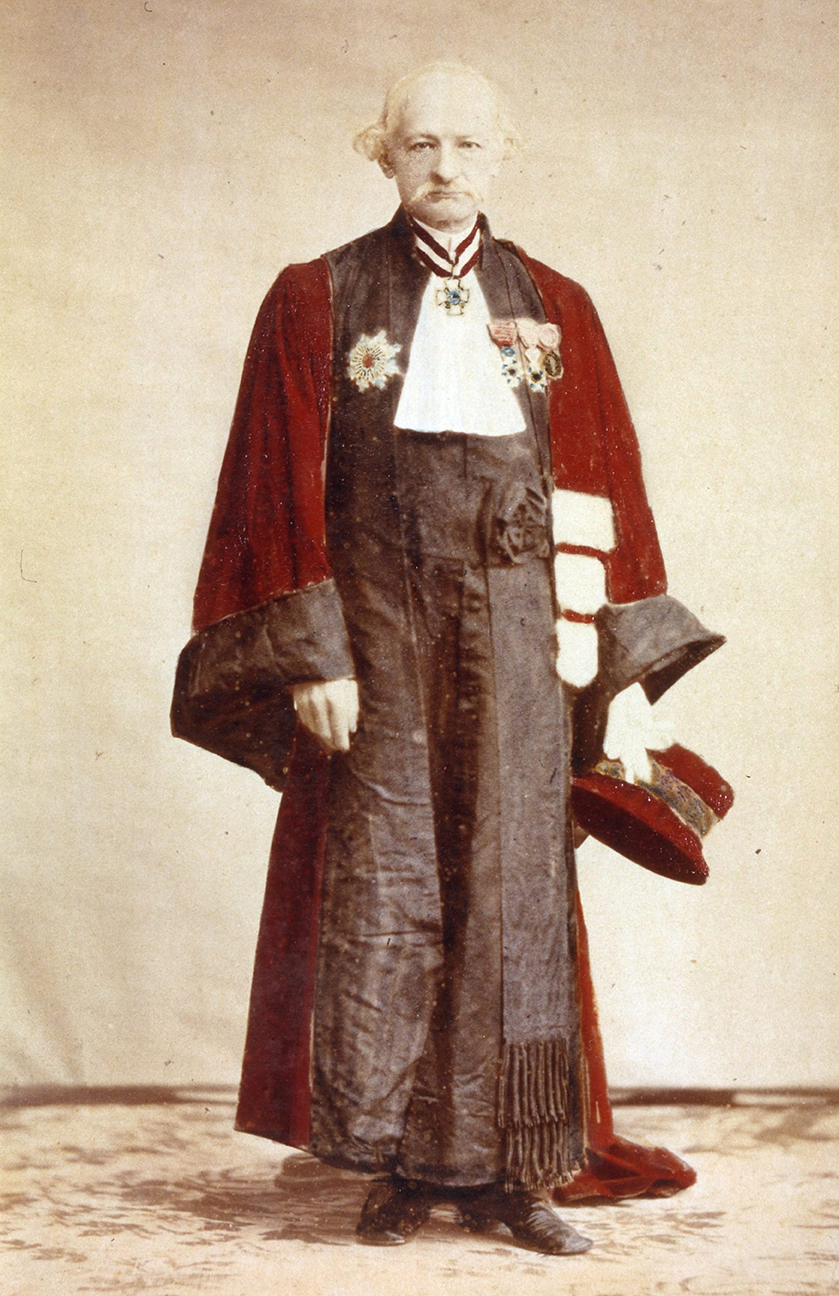
Ironically, Eto, who had suggested inviting the foreign jurist, left his government post due to political changes relating to "Seikanron debate"(debate over the invation of Korea, just before the arrival of Boissonade in 1873. Boissonade would stay in Japan for 22 years and left a great legacy in the form of Japanese civil codes. For example, after the civil law draft based on Mitsukuri’s translation was abolished, Boissonade drafted a new civil law, which was promulgated as a so-called "old civil law” that revisited a prior civil code’s enforcement and abolition. Furthermore, Boissonade drafted the criminal code and also the Criminal Procedural Law of 1880, which was promulgated and implemented. He also had a great influence in the abolishment of torture. In addition to his involvement in matters such as attending Okubo Toshimichi in the negotiations subsequent to the campaign to Formosa, and expressing a dissenting opinion to the treaty revision draft of Foreign Minister Inoue Kaoru, he kept active in various fields as well as the compilation of legal codes.
Among the members of the inspection party who attended Boissonade’s lectures in Paris, many who would go on to play central roles in the development of the Japanese judicial system, such as Inoue, who would draft the Meiji Constitution and Imperial Rescript on Education, and Kishira and Namura who acted as chief justices in the Supreme Court. Ume Kenjiro, who was in charge of drafting the current civil law after the old civil law, was one of the students who studied under Boissonade at the Department of Justice law school. It may be said that Department of Justice benefitted greatly from the Iwakura Mission in contributing to the establishment of Japan’s judicial system.
梅溪昇『お雇い外国人の研究(上・下巻)』(青史出版、2010年)
大久保泰甫『ボワソナアド』(岩波新書、1977年)
川口由彦『日本近代法制史』(新世社、1998年)
毛利敏彦『江藤新平(増補版)』(中公新書、1997年)
Tanaka Fujimaro: The inspection of Western education systems and the modernization of education
The Meiji government began a modernization policy with the Meiji Restoration, which pushed forward the introduction of Japan’s modern education system in place of a traditional hanko (domain school) and terakoya (small private schools of the Edo Period). The Ministry of Education was established in 1871 when an abolition of feudal domains and establishment of prefectures was in effect, and the ministry was charged with the administration of education. The first modern fundamental law of the education system, Gakusei (The Education System Order, promulgated in 1872) was established by the Ministry of Education not long after its inception.
For the modernization of education in Japan, it was deemed necessary to go about preparing the domestic education system by collecting information and inspecting educational systems in America and Europe. As part of the above approach, it was decided that a councilor (an inspector) would be dispatched with the Iwakura Mission from the Ministry of Education. Tanaka Fujimaro (1845-1909) then, a senior officer in the Ministry of Education, was chosen.
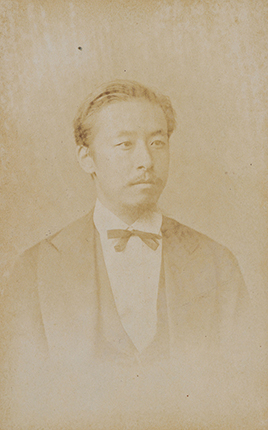
Tanaka from Owari Domain (current Aichi Prefecture) was a deputy assistant professor at Meirindo (a school in Owari Domain) and an aide to its feudal lord in the late Tokugawa period, and later joined new government as councilor after the restoration of imperial rule. His relationship with the educational administration began in 1869 when he was appointed Commissioner of University in the new government. He participated in the Iwakura Mission as a councilor after becoming a senior officer of the Ministry of Education in 1871, and he engaged in research of the European and American educational systems. He was 27 years old at that time – the youngest of all ministry councilors.
Councilor Tanaka and the parties that followed arrived at San Francisco with the mission’s main body on January 15, 1871 (December 6, 1871) and from there commenced inspection of educational facilities in various parts of America. Kido Takayoshi, who was in charge of the education policy for the mission joined in the inspection of the United States and parts of France. In Washington D.C. where they arrived on March 8, 1872, Niijima Jo, who had left Japan illegally in 1864, was employed as an interpreter. It was Mori Arinori who recommended employing Niijima. Mori was then Japanese charge d'affaires to the U.S., and would later become Minister of Education. After this, Niijima was tasked with the translation of materials collected in various parts of the country and the preparation of original form plans of the councilor report, which was compiled later in "Monbusho Riji Kotei (Councilor report, Ministry of Education)." Incidentally, Kondo Shinzo and Imamura Waro separated from the party just after Tanaka’s arrival to Washington. Kondo went to Germany, and Imamura went to France.
On May 11, 1872, after the party finished its inspection of the United States, it traveled to the U.K. in advance of the mission main body, to explore various parts of Europe. Ultimately, the Ministry of Education councilor party stayed in the United States approximately four months, in the U.K. approximately two months, in Prussia approximately four months, and then went on to France, Switzerland, Russia, the Netherlands and Denmark. The Ministry of Education councilor party finished its inspection and left Europe in February, 1873 to return home on March 24.
After returning to Japan, the Ministry of Education published "Councilor report, Ministry of Education" under the title of "Riji Kotei (Councilor report)" by the Tanaka councilor party (1873-1875). Only the Ministry of Education would publish reports of the councilors to the public, with the exception of Yasukawa Shigenari of the Mission Legislative Chamber (Sa-in). From this source, it became known that Tanaka and others intended to spread the results throughout Japan.
Tanaka himself became Deputy Vice-Minister of Education in 1873, Vice-Minister of Education the following year, and would become a central figure within the education administration. He traveled again in the United States in 1876 for approximately one year, making deep onsite surveys of the educational system. Based on the results of his survey, the "Kyoiku-rei (The Education Order)" was established as the new fundamental law of education in place of the Gakusei (The Education System Order). Tanaka’s two overseas experiences are clearly reflected in the content of his survey, in which he advocated for modernization, raising educational levels, de-centralizing the educational system and greater autonomy for schools to reflect the specific contexts of local districts.
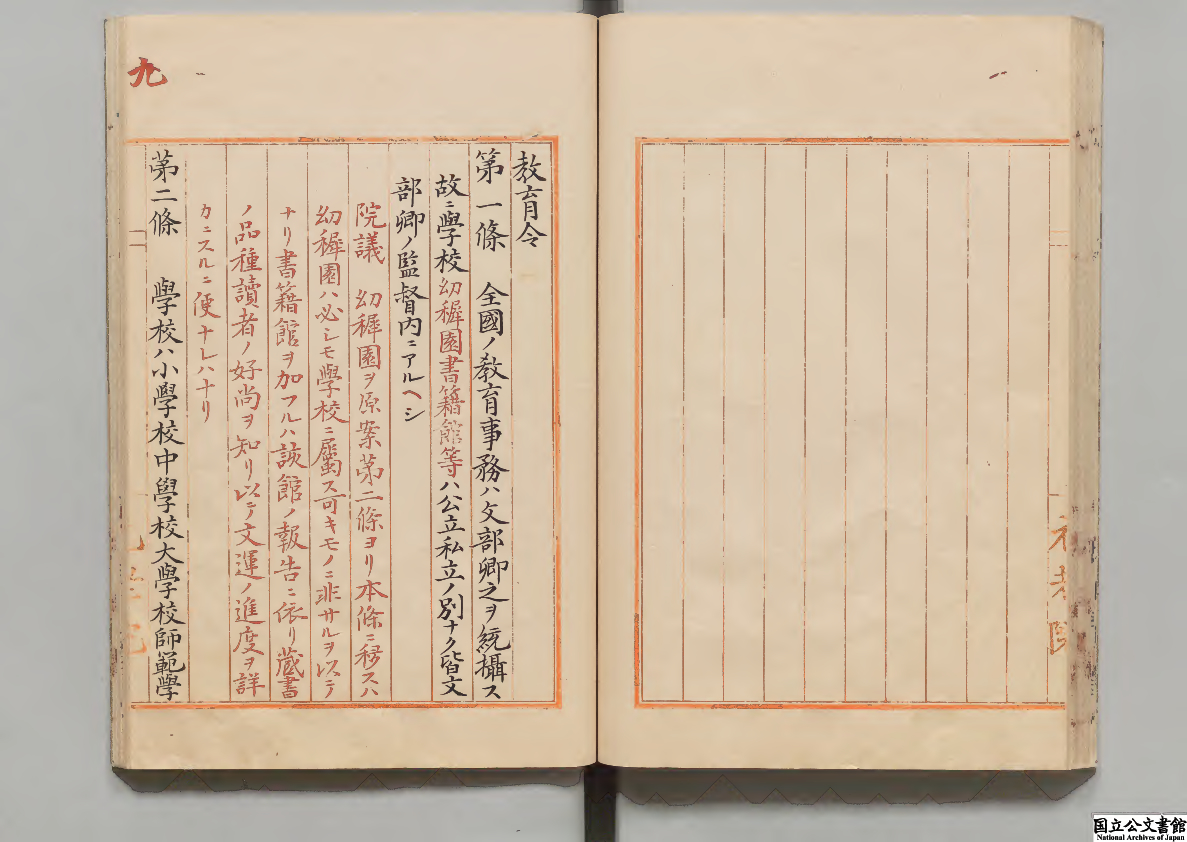
Specifically, the following content was incorporated: (1) cooperation of schools with outside organizations, such as libraries, museums, and kindergarten; (2) basic education for boys and girls would include the same academic subjects; (3) emphasis on morals in education where children learn morals in everyday school life; (4) introduction to European and American educational regulations prohibiting physical punishment; (5) the goals of making the most out of a primary school education, modernizing the whole of society and building a national consciousness. In the process of establishing ordinances, the "Reports of councilors" and materials of investigation on educational systems collected and compiled from foreign countries were utilized for suppressing the arguments of Ito Hirobumi and others who made so much of secondary and higher education for good upbringing.
In this way, Tanaka Fujimaro endeavored to modernize education in Japan but, as Kyoiku-rei came under criticism by conservatives who mistakenly believed that the ideas within "might promote non-interference education," he was transferred out of the education field and appointed minister of justice in 1880. He would never return to educational administration. The Kyoiku-rei was revised in 1880 and 1885, but remained relevant as the basic law of the education. Legislation for education changed dramatically after Mori Arinori, who welcomed the Iwakura Mission in the United States, took office as Minister of Education in 1885. The fundamental law of education changed to a series of school ordinances the Gakko-rei (Order of School System) from Kyoiku-rei in 1886 and the Imperial Rescript on Education drafted by Inoue Kowashi and others was presented to people of Japan in the name of Emperor in 1890 the following year when Mori Arinori was assassinated. The education policy since the days of Tanaka Fujimaro had changed dramatically.
小林哲也「解説」『理事功程 復刻版』(臨川書店、1973年)
小林哲也「『理事功程』研究ノート」(『京都大学教育学部紀要』20、1974年)
文部省編『学制百年史』(帝国地方行政学会、1981年)
文部省編『学制百二十年史』(ぎょうせい、1992年)
森川輝紀『増補版 教育勅語への道 教育の政治史』(三元社、2011年)
湯川文彦『立法と事務の明治維新 ―官民共治の構想と展開―』(東京大学出版会、2017年)
Lives of former study abroad students and modern Japan
Any discussion of modern history in Japan in the areas of politics, economics, education, or thought would be difficult without mentioning members of the Iwakura Mission. The influence of the mission is long-lasting due to the fact that not only influential politicians and bureaucrats in active service such as Iwakura Tomomi, Kido Takayoshi, Okubo Toshimichi, and Ito Hirobumi attended, but also through the participation of young who studied abroad, including students like Tsuda Ume, a girl, just six years old.
43 students are thought to have officially joined the Iwakura Mission, but there were other attendants to the ambassadors and commissioners who studied abroad. These included many children of court nobles and former daimyo (feudal lords) who became prefectural governors. Among attendants, the children of the former shogunate retainers and former Aizu samurais, such as the female students dispatched the Hokkaido Development Commission, were also present, as were relatives of influential people such as Makino Nobuaki, Yamagata Isaburo and others.
Among the overseas students, Makino Nobuaki, Kaneko Kentaro, Hirata Tosuke, and Yamagata Isaburo would rise to the rank of cabinet ministers. Makino Nobuaki was the second son of the full power Envoy Extraordinary and Minister Plenipotentiary Okubo Toshimichi. His studies in the United States lasted for approximately two and a half years and he would go on to enter the Ministry of Foreign Affairs where he would hold successive positions as a legislative bureaucrat, local government official, vice-minister of the Ministry of Education, minister of education, minister of agriculture and commerce, minister of foreign affairs, and would later took charge of the delegation practically as second ambassador plenipotentiary in the Paris Peace Conference. He was also a confidant of Emperor Showa while he acted as the Imperial Household Minister and lord keeper of the Privy Seal in the interwar period. In the postwar period, he was an influential adviser to the emperor and Imperial Court, and was father-in-law of Prime Minister Yoshida Shigeru.
Kaneko Kentaro worked on the Meiji Constitution, and held successive posts as minister of agriculture and commerce and minister of justice after the Iwakura Mission, continued his study of law at Harvard University. Making good use of his network of school friends, such as Theodore Roosevelt, who would become President of the United States, Kaneko’s efforts to bolster Japan-U.S. friendship would continue throughout his life.
The influence of foreign study after the Iwakura Mission was clearly visible due to consistent pro-Britain and pro-United States tendencies that colored post-mission careers, and it is surprising that this influence reached as far as the postwar period.
Yamagata Isaburo and Hirata Tosuke studied in Germany while many other group of members concentrated in the United States. Isaburo who was an adopted child of Yamagata Aritomo was promoted to the rank of official for the Ministry of Home Affairs and later became minister of communications and inspector-general of political affairs of the Government-General of Korea.
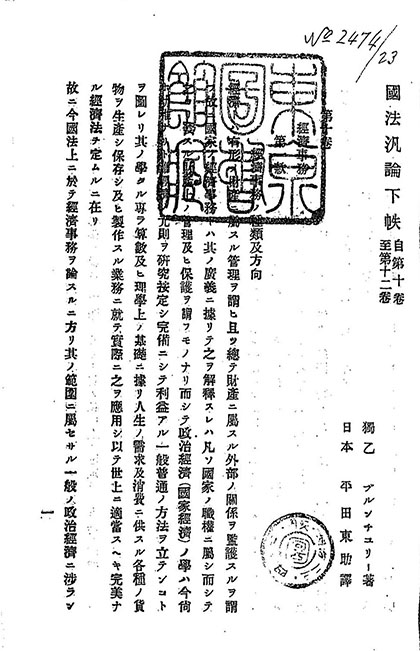
Hirata Tosuke studied political science, economics and law. He was the first Japanese to earn a doctorate from Heidelberg University. Of particular note is that Hirata studied constitutional law and organic theory of the state from Gneist at Berlin University as well as Bluntschli and others at Heidelberg University. Hirata published the writings of Bluntschli in translation after returning to Japan, but distinguished himself as a legislative bureaucrat by influencing the Meiji government to choose German constitutional law and the organic theory of state. While Hirata was from Yonezawa Domain, he was acting chief of the Judicial Bureau, minister of agriculture and commerce, home minister and was influential to the Yamagata (Aritomo) line in addition to being lord keeper of the Privy Seal. It can be said that these men exemplified the way that their scholastic experiences abroad contributed to their successful bid for the Meiji government to design policy based on the German model.
The influence of Nakae Chomin cannot be overlooked in post-Iwakura Mission Japanese political history or history of thought. Nakae was among the overseas students accompanying the Iwakura Mission. Nakae, who negotiated directly with Okubo Toshimichi, received a post as a government official after returning from his studies in France. However, he spent much time out of the office writing, and became a leader of the movement for democratic rights. Thus, did the legacy of the Iwakura Mission spread over the civilian society.
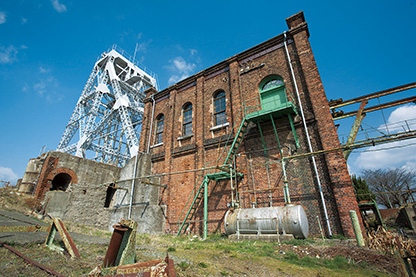
Dan Takuma, who later dominated the world of finance as leader of Mitsui-zaibatsu (Mitsui financial group), joined the Iwakura Mission and remained in the U.S., studying mining at Massachusetts Institute of Technology. After returning to Japan, Dan worked in the Miike coalmine section of the Construction Bureau. This would become the first step in his career in the Mitsui-zaibatsu, as Miike coalmine was granted to Mitsui. He proved himself an effective leader and his status rose. The source of Dan’s success was most certainly rooted in the mining education he received in the United States.
Needless to say, Tsuda Ume’s contributions to education were tremendous. Tsuda, who studied biology at Bryn Mawr College, went on to establish Joshi Eigaku Juku (Women’s School of English Studies, forerunner of Tsuda College), and pushed for the advancement of women’s education in Japan. Other female foreign scholars included Nagai Shige (later, Uryu Shige), who studied musicology at Vassar College and would later build the foundations for music education at the Ministry of Education’s Music Bureau and also the Tokyo Music School. If Niijima Jo (founder of Doshisha University) who attended the mission while still enrolled in a theological college in the United States, and Watanabe Hiromoto (the first President of Tokyo Imperial University) who was a secretary for the mission, are included in the group, the overseas students can be seen to have had an immeasurable influence on the foundations of the modern Japanese academics.
Not all the students on the Iwakura Mission would achieve success. For example, Shuntaro, eldest son of Envoy Extraordinary and Minister Plenipotentiary Yamaguchi Masuka, spent nine years studying in the U.K. and then graduated from the College of Engineering, Imperial University, only to wander Kyushu Railway, work at MITSUI & Co., Ltd. as a railway engineer, and manage railway offices. In the end, he would fail in the oil engine business. The era in which one could succeed and join the ranks of the elite just from excellence in language, or extensive experience in foreign countries was coming to an end.
Taking cases like those above into consideration, it may be said that the influence that the students of the Iwakura Mission brought to modern Japan was great indeed. From the bureaucratic world, to finance, to civil rights and education, the Iwakura Mission students had a tremendous influence on creating Japan as it is known today.
茶谷誠一『人物叢書 牧野伸顕』(吉川弘文館、2013年)
並松信久「平田東助と社会政策の展開―制度設計の課題」(『京都産業大学論集』32、2015年)
生田澄江『舞踏への勧誘―日本最初の女子留学生永井繁子の生涯』(文芸社、2003年)
The life of Tsuda Ume after her return to Japan
It is said that Kuroda Kiyotaka, vice-minister of the Colonization Commission after the Meiji Restoration, learned of the relatively high social status of women in the West while inspecting development work and realized the importance of women’s education. For this reason, female students were recruited for establishment of girls' schools and vocational training in Hokkaido. Ffive women were selected to join the Iwakura Mission, Yamakawa Sutematsu, Tsuda Ume, Nagai Shige, Ueda Tei and Yoshsimasu Ryo.
Six-year-old Tsuda Ume was the youngest, and would continue her studies abroad for 11 years and ultimately graduate, in Washington D.C., from Archer Institute. After returning to Japan, she is known for having founded Joshi Eigaku Juku (Women's School of English Studies), which was the forerunner of Tsuda College. Her activities after returning to Japan until founding her college are summarized as follows.
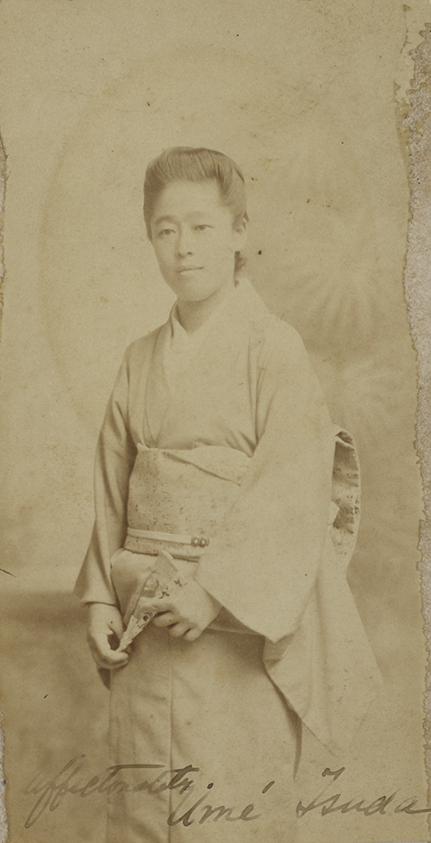
After Tsuda was dispatched abroad at age six, jurisdiction over female students overseas had been transferred to the Ministry of Education from the Colonization Commission, and the Colonization Commission itself was abolished when she returned to Japan in 1882. Tsuda, who finished her elementary and secondary school education abroad at government expense, wanted to dedicate herself to women’s education in Japan, but the Ministry of Education was not helpful in finding her work.
In Japan, there was a tendency for women to get married at a young age and settle into household work. Therefore, education for women was seen as unnecessary and girls lagged in comparison to boys in the educational system. Due to this perception, it was difficult for Tsuda to fulfill her ambitions. Making matters worse, Tsuda no longer had a good command of the Japanese language because of her many years abroad, and she was therefore not qualified to find suitable work.
It was Ito Hirobumi, envoy extraordinary and minister plenipotentiary of the Iwakura Mission that assisted Tsuda. Ito let Tsuda stay in his home, asked her to be his English interpreter and tutor to his wife and daughter. Tsuda was encouraged to get married by various people, but she decided to live stay unmarried and live in obscurity while studying Japanese.
In 1885, three years after returning to Japan, she was able to find a long-awaited job. A government institution, the Peeresses' School, was opened, and Tsuda was employed as assistant professor on recommendation from Ito.
Tsuda had taken a big step to in becoming a school teacher, but the educational thought at the time, that women should be good wives and wise mothers, made her goals challenging. Under the educational policy of the Peeresses' School, girls were educated separately from boys, and subjects useful only for household affairs were provided for girls. Under such circumstances, Tsuda began wanting to move into a higher education setting in order to continue her scholastic growth.
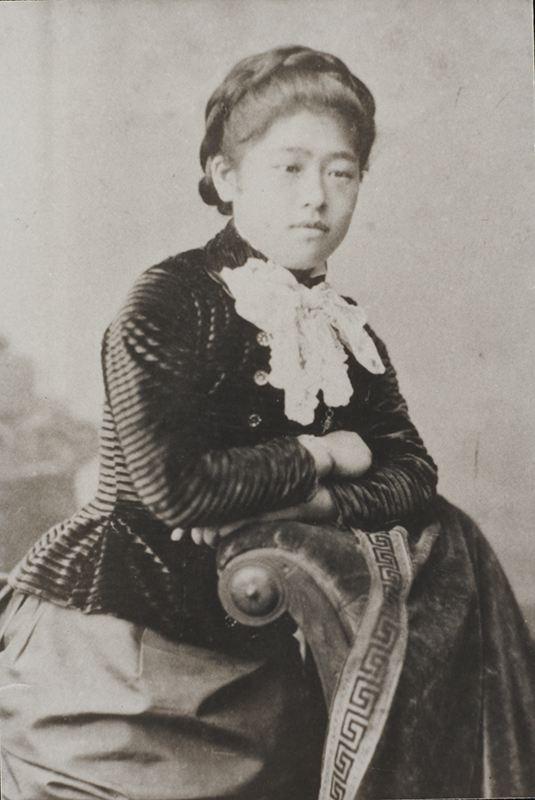
In 1889, Ume took a leave of absence from the Peeresses' School and set off once again for the United States in order to receive higher education. Her destination would be Bryn Mawr College in the suburbs of Philadelphia, a women's college that was founded at the same time as the Peeresses' School in 1885. At the time the dean of the college was M. Carey Thomas who was seven years Tsuda’s senior. This encounter proved to be a great influence on Tsuda’s view of education.
In the United States as in Japan, the educational place for women was widely thought to be the home. Thomas herself had struggled under this situation and had gone to Switzerland to acquire a doctorate from University of Zurich with highest distinction. She was the first woman to receive a doctorate from that university. Furthermore, when she was appointed as dean of Bryn Mawr College, she did away with the subject of home economics which was peculiar to girls' education, prepared the way for science, and proceeded with reforms such as creating graduate programs.
Tsuda majored in biology. Her success showed in her published research papers. She would spend three fruitful years at Oswego Primary Teachers Training School where she learned teaching methods for half a year. Ume respected Thomas’ push for the development of higher education for women as a good model to follow.
After returning to Japan, Tsuda taught at Peeresses' School again, while planning to found a school at which Japanese women could receive higher education to reach their potential. The government finally launched systemic reforms in women’s education in response to the changes in the domestic situation that accompanied the Sino-Japanese War of 1894-1895, and the increase in girls' schools came without a firm institutional basis. "The Women’s Higher Education Law" and "Order of Private Schools" were promulgated in 1899, a system of the girls' secondary education was established and with that came increased expectations for higher education.
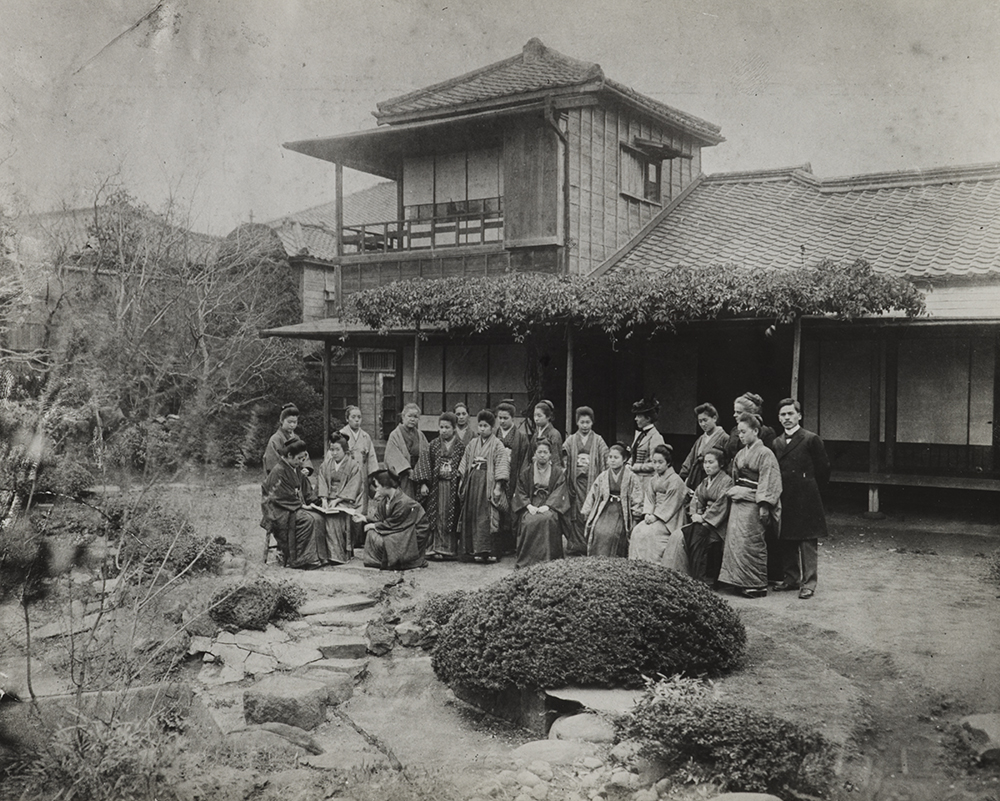
The following year, Tsuda resigned from Peeresses' School at which she had served for 15 years. Before the institutionalization of the higher education, she had announced the founding of her school, Joshi Eigaku Juku (Women's School of English Studies) as an educational institution specializing in the training of English teachers. The operation of the above school was dependent to a large degree on the support of American women. In response to Tsuda’s appeal for assistance, her friend Alice Bacon visited Japan and became a teacher to support the school. Furthermore, Philadelphia Committee’s Dean Thomas, who had taken the job of president of Bryn Mawr College, participated and matters were organized so as to support Tsuda’s school on the financial front.
In 1903, Joshi Eigaku Juku was accredited as a technical school following the proclamation of the "Vocational Training School Order," and the conferment of the English teacher's license without examination for women became possible for the first time. These movements paved the way for women to acquire specialized knowledge, and go out into the world independently. In this way, Tsuda Ume opened a new era for women’s higher education.
Today, Japanese women have opportunities to receive higher education and move upward in society. When tracing the roots, we find the lifelong devotion of women such as Tsuda Ume from the Meiji Period.
久野明子『鹿鳴館の貴婦人大山捨松―日本初の女子留学生―』(中央公論社、1988年)
吉川利一『津田梅子』(中公文庫、1990年)
飯野正子・亀田帛子・髙橋裕子編『津田梅子を支えた人びと』(有斐閣、2000年)
髙橋裕子『津田梅子の社会史』(玉川大学出版部、2002年)


